Molecule Information
General Information of the Molecule (ID: Mol00515)
| Name |
ATP-binding cassette sub-family C5 (ABCC5)
,Homo sapiens
|
||||
|---|---|---|---|---|---|
| Synonyms |
Multi-specific organic anion transporter C; MOAT-C; Multidrug resistance-associated protein 5; SMRP; pABC11; MRP5
Click to Show/Hide
|
||||
| Molecule Type |
Protein
|
||||
| Gene Name |
ABCC5
|
||||
| Gene ID | |||||
| Location |
chr3:183919934-184017939[-]
|
||||
| Sequence |
MKDIDIGKEYIIPSPGYRSVRERTSTSGTHRDREDSKFRRTRPLECQDALETAARAEGLS
LDASMHSQLRILDEEHPKGKYHHGLSALKPIRTTSKHQHPVDNAGLFSCMTFSWLSSLAR VAHKKGELSMEDVWSLSKHESSDVNCRRLERLWQEELNEVGPDAASLRRVVWIFCRTRLI LSIVCLMITQLAGFSGPAFMVKHLLEYTQATESNLQYSLLLVLGLLLTEIVRSWSLALTW ALNYRTGVRLRGAILTMAFKKILKLKNIKEKSLGELINICSNDGQRMFEAAAVGSLLAGG PVVAILGMIYNVIILGPTGFLGSAVFILFYPAMMFASRLTAYFRRKCVAATDERVQKMNE VLTYIKFIKMYAWVKAFSQSVQKIREEERRILEKAGYFQSITVGVAPIVVVIASVVTFSV HMTLGFDLTAAQAFTVVTVFNSMTFALKVTPFSVKSLSEASVAVDRFKSLFLMEEVHMIK NKPASPHIKIEMKNATLAWDSSHSSIQNSPKLTPKMKKDKRASRGKKEKVRQLQRTEHQA VLAEQKGHLLLDSDERPSPEEEEGKHIHLGHLRLQRTLHSIDLEIQEGKLVGICGSVGSG KTSLISAILGQMTLLEGSIAISGTFAYVAQQAWILNATLRDNILFGKEYDEERYNSVLNS CCLRPDLAILPSSDLTEIGERGANLSGGQRQRISLARALYSDRSIYILDDPLSALDAHVG NHIFNSAIRKHLKSKTVLFVTHQLQYLVDCDEVIFMKEGCITERGTHEELMNLNGDYATI FNNLLLGETPPVEINSKKETSGSQKKSQDKGPKTGSVKKEKAVKPEEGQLVQLEEKGQGS VPWSVYGVYIQAAGGPLAFLVIMALFMLNVGSTAFSTWWLSYWIKQGSGNTTVTRGNETS VSDSMKDNPHMQYYASIYALSMAVMLILKAIRGVVFVKGTLRASSRLHDELFRRILRSPM KFFDTTPTGRILNRFSKDMDEVDVRLPFQAEMFIQNVILVFFCVGMIAGVFPWFLVAVGP LVILFSVLHIVSRVLIRELKRLDNITQSPFLSHITSSIQGLATIHAYNKGQEFLHRYQEL LDDNQAPFFLFTCAMRWLAVRLDLISIALITTTGLMIVLMHGQIPPAYAGLAISYAVQLT GLFQFTVRLASETEARFTSVERINHYIKTLSLEAPARIKNKAPSPDWPQEGEVTFENAEM RYRENLPLVLKKVSFTIKPKEKIGIVGRTGSGKSSLGMALFRLVELSGGCIKIDGVRISD IGLADLRSKLSIIPQEPVLFSGTVRSNLDPFNQYTEDQIWDALERTHMKECIAQLPLKLE SEVMENGDNFSVGERQLLCIARALLRHCKILILDEATAAMDTETDLLIQETIREAFADCT MLTIAHRLHTVLGSDRIMVLAQGQVVEFDTPSVLLSNDSSRFYAMFAAAENKVAVKG Click to Show/Hide
|
||||
| Function |
ATP-dependent transporter of the ATP-binding cassette (ABC) family that actively extrudes physiological compounds, and xenobiotics from cells. Mediates ATP-dependent transport of endogenous metabolites such as cAMP and cGMP, folic acid and N-lactoyl-amino acids (in vitro). Acts also as a general glutamate conjugate and analog transporter that can limit the brain levels of endogenous metabolites, drugs, and toxins. Confers resistance to the antiviral agent PMEA. Able to transport several anticancer drugs including methotrexate, and nucleotide analogs in vitro, however it does with low affinity, thus the exact role of ABCC5 in mediating resistance still needs to be elucidated. Acts as a heme transporter required for the translocation of cytosolic heme to the secretory pathway. May play a role in energy metabolism by regulating the glucagon-like peptide 1 (GLP-1) secretion from enteroendocrine cells.
Click to Show/Hide
|
||||
| Uniprot ID | |||||
| Ensembl ID | |||||
| HGNC ID | |||||
| Click to Show/Hide the Complete Species Lineage | |||||
Type(s) of Resistant Mechanism of This Molecule
Drug Resistance Data Categorized by Drug
Approved Drug(s)
8 drug(s) in total
| Drug Resistance Data Categorized by Their Corresponding Mechanisms | ||||
|
|
||||
| Disease Class: Glaucoma | [1] | |||
| Resistant Disease | Glaucoma [ICD-11: 9C61.0] | |||
| Resistant Drug | Adefovir | |||
| Molecule Alteration | Expression | Regulation |
||
| Experimental Note | Identified from the Human Clinical Data | |||
| In Vitro Model | SIRC cells | Colon | Homo sapiens (Human) | CVCL_2724 |
| SV40-HCEC cells | Kidney | Homo sapiens (Human) | CVCL_1272 | |
| Experiment for Molecule Alteration |
RT-PCR; Immunoprecipitation assay; Western blot analysis; Immunostaining assay | |||
| Experiment for Drug Resistance |
Trypan blue exclusion test assay | |||
| Mechanism Description | Taken together immunolocalization on human cornea, in vitro efflux in human, rabbit corneal and MRP5 over expressing cells, ex vivo and in vivo studies in intact rabbit cornea suggest that MRP5 on cornea can significantly lower the permeability of antiviral and glaucoma drugs. | |||
| Disease Class: Glaucoma | [1] | |||
| Resistant Disease | Glaucoma [ICD-11: 9C61.0] | |||
| Resistant Drug | Adefovir | |||
| Molecule Alteration | Expression | Regulation |
||
| Experimental Note | Identified from the Human Clinical Data | |||
| In Vitro Model | SIRC cells | Colon | Homo sapiens (Human) | CVCL_2724 |
| SV40-HCEC cells | Kidney | Homo sapiens (Human) | CVCL_1272 | |
| Experiment for Molecule Alteration |
RT-PCR; Immunoprecipitation assay; Western blot analysis; Immunostaining assay | |||
| Experiment for Drug Resistance |
Trypan blue exclusion test assay | |||
| Mechanism Description | Taken together immunolocalization on human cornea, in vitro efflux in human, rabbit corneal and MRP5 over expressing cells, ex vivo and in vivo studies in intact rabbit cornea suggest that MRP5 on cornea can significantly lower the permeability of antiviral and glaucoma drugs. | |||
| Drug Resistance Data Categorized by Their Corresponding Mechanisms | ||||
|
|
||||
| Disease Class: Rheumatoid arthritis | [2] | |||
| Resistant Disease | Rheumatoid arthritis [ICD-11: FA20.0] | |||
| Resistant Drug | Azathioprine | |||
| Molecule Alteration | Expression | Up-regulation |
||
| Experimental Note | Identified from the Human Clinical Data | |||
| Mechanism Description | MTX is a substrate for eight ABC transporters. In vitro studies demonstrated that RAFLS treated with MTX had higher ABCB1 expression levels than controls, with a positive correlation between ABCB1 expression levels and RA treatment duration. In addition to MTX, other DMARDs (e.g. sulfasalazine, leflunomide, bucillamine, azathioprine), glucocorticoids (e.g. betamethasone, dexamethasone), and NSAIDs (e.g. celecoxib and indomethacin) are also substrates of ABC transporters. | |||
| Drug Resistance Data Categorized by Their Corresponding Mechanisms | ||||
|
|
||||
| Disease Class: Glaucoma | [1] | |||
| Resistant Disease | Glaucoma [ICD-11: 9C61.0] | |||
| Resistant Drug | Bimatoprost | |||
| Molecule Alteration | Expression | Regulation |
||
| Experimental Note | Identified from the Human Clinical Data | |||
| In Vitro Model | SIRC cells | Colon | Homo sapiens (Human) | CVCL_2724 |
| SV40-HCEC cells | Kidney | Homo sapiens (Human) | CVCL_1272 | |
| Experiment for Molecule Alteration |
RT-PCR; Immunoprecipitation assay; Western blot analysis; Immunostaining assay | |||
| Experiment for Drug Resistance |
Trypan blue exclusion test assay | |||
| Mechanism Description | Taken together immunolocalization on human cornea, in vitro efflux in human, rabbit corneal and MRP5 over expressing cells, ex vivo and in vivo studies in intact rabbit cornea suggest that MRP5 on cornea can significantly lower the permeability of antiviral and glaucoma drugs. | |||
| Disease Class: Glaucoma | [1] | |||
| Resistant Disease | Glaucoma [ICD-11: 9C61.0] | |||
| Resistant Drug | Bimatoprost | |||
| Molecule Alteration | Expression | Regulation |
||
| Experimental Note | Identified from the Human Clinical Data | |||
| In Vitro Model | SIRC cells | Colon | Homo sapiens (Human) | CVCL_2724 |
| SV40-HCEC cells | Kidney | Homo sapiens (Human) | CVCL_1272 | |
| Experiment for Molecule Alteration |
RT-PCR; Immunoprecipitation assay; Western blot analysis; Immunostaining assay | |||
| Experiment for Drug Resistance |
Trypan blue exclusion test assay | |||
| Mechanism Description | Taken together immunolocalization on human cornea, in vitro efflux in human, rabbit corneal and MRP5 over expressing cells, ex vivo and in vivo studies in intact rabbit cornea suggest that MRP5 on cornea can significantly lower the permeability of antiviral and glaucoma drugs. | |||
| Drug Resistance Data Categorized by Their Corresponding Mechanisms | ||||
|
|
||||
| Disease Class: Ovarian cancer | [3] | |||
| Resistant Disease | Ovarian cancer [ICD-11: 2C73.0] | |||
| Resistant Drug | Cisplatin | |||
| Molecule Alteration | Expression | Up-regulation |
||
| Experimental Note | Revealed Based on the Cell Line Data | |||
| Cell Pathway Regulation | Cell proliferation | Activation | hsa05200 | |
| In Vitro Model | SkOV3 cells | Ovary | Homo sapiens (Human) | CVCL_0532 |
| OVCAR3 cells | Ovary | Homo sapiens (Human) | CVCL_0465 | |
| PEO14 cells | Ovary | Homo sapiens (Human) | CVCL_2687 | |
| In Vivo Model | Nude mouse xenograft model | Mus musculus | ||
| Experiment for Molecule Alteration |
Western blot analysis | |||
| Experiment for Drug Resistance |
CCK8 assay | |||
| Mechanism Description | Overexpression of miR-128 resensitized SkOV3/CP cells to cisplatin and reduced the expression of cisplatin-resistant-related proteins ABCC5 and Bmi-1. | |||
| Drug Resistance Data Categorized by Their Corresponding Mechanisms | ||||
|
|
||||
| Disease Class: Breast cancer | [4] | |||
| Resistant Disease | Breast cancer [ICD-11: 2C60.3] | |||
| Resistant Drug | Doxorubicin | |||
| Molecule Alteration | Expression | Up-regulation |
||
| Experimental Note | Identified from the Human Clinical Data | |||
| Cell Pathway Regulation | Cell apoptosis | Inhibition | hsa04210 | |
| In Vitro Model | MCF-7 cells | Breast | Homo sapiens (Human) | CVCL_0031 |
| SkBR3 cells | Breast | Homo sapiens (Human) | CVCL_0033 | |
| Experiment for Molecule Alteration |
Western blotting analysis | |||
| Experiment for Drug Resistance |
MTT assay | |||
| Mechanism Description | Reduction of miR-128 in BT-ICs leads to overexpression of Bmi-1 and ABCC5, two independent targets of miR-128. Ectopic expression of miR-128 decreases cell viability and increases apoptosis and DNA damage in the presence of doxorubicin, hence sensitizes BT-ICs to chemotherapy. | |||
| Drug Sensitivity Data Categorized by Their Corresponding Mechanisms | ||||
|
|
||||
| Disease Class: Gastric cancer | [5] | |||
| Sensitive Disease | Gastric cancer [ICD-11: 2B72.1] | |||
| Sensitive Drug | Doxorubicin | |||
| Molecule Alteration | Expression | Down-regulation |
||
| Experimental Note | Revealed Based on the Cell Line Data | |||
| In Vitro Model | SGC7901 cells | Gastric | Homo sapiens (Human) | CVCL_0520 |
| In Vivo Model | Nude mouse xenograft model | Mus musculus | ||
| Experiment for Molecule Alteration |
Western blot analysis | |||
| Experiment for Drug Resistance |
MTT assay | |||
| Mechanism Description | The over-expressed miR-129-5p reduced the chemo-resistance of SGC7901/VCR and SGC7901/ADR cells, while down-regulation of miR-129-5p had an opposite effect. Furthermore, three members of multi-drug resistance (MDR) related ABC transporters (ABCB1, ABCC5 and ABCG1) were found to be direct targets of miR-129-5p using bioinformatics analysis and report gene assays. The present study indicated that hyper-methylation of miR-129-5p CpG island might play important roles in the development of gastric cancer chemo-resistance by targeting MDR related ABC transporters and might be used as a potential therapeutic target in preventing the chemo-resistance of gastric cancer. | |||
| Drug Sensitivity Data Categorized by Their Corresponding Mechanisms | ||||
|
|
||||
| Disease Class: Pancreatic cancer | [6] | |||
| Sensitive Disease | Pancreatic cancer [ICD-11: 2C10.3] | |||
| Sensitive Drug | Gemcitabine | |||
| Molecule Alteration | Expression | Down-regulation |
||
| Experimental Note | Identified from the Human Clinical Data | |||
| In Vitro Model | BxPC-3 cells | Pancreas | Homo sapiens (Human) | CVCL_0186 |
| MIA PaCa-2 cells | Pancreas | Homo sapiens (Human) | CVCL_0428 | |
| AsPC-1 cells | Pancreas | Homo sapiens (Human) | CVCL_0152 | |
| In Vivo Model | Chick egg xenograft model | Gallus gallus | ||
| Experiment for Molecule Alteration |
Dual luciferase assay; qRT-PCR; Immunofluorescence and immunohistochemistry assay | |||
| Experiment for Drug Resistance |
RealTime-Glo MT Cell Viability Assay; Caspase-3/7 substrate assay; Colony formation assay | |||
| Mechanism Description | microRNA-210 overexpression inhibits tumor growth and potentially reverses gemcitabine resistance in pancreatic cancer, miR210 is a direct suppressor of the multidrug efflux transporter ABCC5. | |||
| Drug Resistance Data Categorized by Their Corresponding Mechanisms | ||||
|
|
||||
| Disease Class: Glaucoma | [1] | |||
| Resistant Disease | Glaucoma [ICD-11: 9C61.0] | |||
| Resistant Drug | Latanoprost | |||
| Molecule Alteration | Expression | Regulation |
||
| Experimental Note | Identified from the Human Clinical Data | |||
| In Vitro Model | SIRC cells | Colon | Homo sapiens (Human) | CVCL_2724 |
| SV40-HCEC cells | Kidney | Homo sapiens (Human) | CVCL_1272 | |
| Experiment for Molecule Alteration |
RT-PCR; Immunoprecipitation assay; Western blot analysis; Immunostaining assay | |||
| Experiment for Drug Resistance |
Trypan blue exclusion test assay | |||
| Mechanism Description | Taken together immunolocalization on human cornea, in vitro efflux in human, rabbit corneal and MRP5 over expressing cells, ex vivo and in vivo studies in intact rabbit cornea suggest that MRP5 on cornea can significantly lower the permeability of antiviral and glaucoma drugs. | |||
| Disease Class: Glaucoma | [1] | |||
| Resistant Disease | Glaucoma [ICD-11: 9C61.0] | |||
| Resistant Drug | Latanoprost | |||
| Molecule Alteration | Expression | Regulation |
||
| Experimental Note | Identified from the Human Clinical Data | |||
| In Vitro Model | SIRC cells | Colon | Homo sapiens (Human) | CVCL_2724 |
| SV40-HCEC cells | Kidney | Homo sapiens (Human) | CVCL_1272 | |
| Experiment for Molecule Alteration |
RT-PCR; Immunoprecipitation assay; Western blot analysis; Immunostaining assay | |||
| Experiment for Drug Resistance |
Trypan blue exclusion test assay | |||
| Mechanism Description | Taken together immunolocalization on human cornea, in vitro efflux in human, rabbit corneal and MRP5 over expressing cells, ex vivo and in vivo studies in intact rabbit cornea suggest that MRP5 on cornea can significantly lower the permeability of antiviral and glaucoma drugs. | |||
| Drug Sensitivity Data Categorized by Their Corresponding Mechanisms | ||||
|
|
||||
| Disease Class: Gastric cancer | [5] | |||
| Sensitive Disease | Gastric cancer [ICD-11: 2B72.1] | |||
| Sensitive Drug | Vincristine | |||
| Molecule Alteration | Expression | Down-regulation |
||
| Experimental Note | Revealed Based on the Cell Line Data | |||
| In Vitro Model | SGC7901 cells | Gastric | Homo sapiens (Human) | CVCL_0520 |
| In Vivo Model | Nude mouse xenograft model | Mus musculus | ||
| Experiment for Molecule Alteration |
Western blot analysis | |||
| Experiment for Drug Resistance |
MTT assay | |||
| Mechanism Description | The over-expressed miR-129-5p reduced the chemo-resistance of SGC7901/VCR and SGC7901/ADR cells, while down-regulation of miR-129-5p had an opposite effect. Furthermore, three members of multi-drug resistance (MDR) related ABC transporters (ABCB1, ABCC5 and ABCG1) were found to be direct targets of miR-129-5p using bioinformatics analysis and report gene assays. The present study indicated that hyper-methylation of miR-129-5p CpG island might play important roles in the development of gastric cancer chemo-resistance by targeting MDR related ABC transporters and might be used as a potential therapeutic target in preventing the chemo-resistance of gastric cancer. | |||
Disease- and Tissue-specific Abundances of This Molecule
ICD Disease Classification 02

| Differential expression of molecule in resistant diseases | ||
| The Studied Tissue | Gastric tissue | |
| The Specified Disease | Gastric cancer | |
| The Expression Level of Disease Section Compare with the Healthy Individual Tissue | p-value: 2.22E-01; Fold-change: -1.88E+00; Z-score: -1.52E+00 | |
| The Expression Level of Disease Section Compare with the Adjacent Tissue | p-value: 3.65E-07; Fold-change: -1.97E+00; Z-score: -2.18E+00 | |
|
Molecule expression in the normal tissue adjacent to the diseased tissue of patients
Molecule expression in the diseased tissue of patients
Molecule expression in the normal tissue of healthy individuals
|
||
| Disease-specific Molecule Abundances |
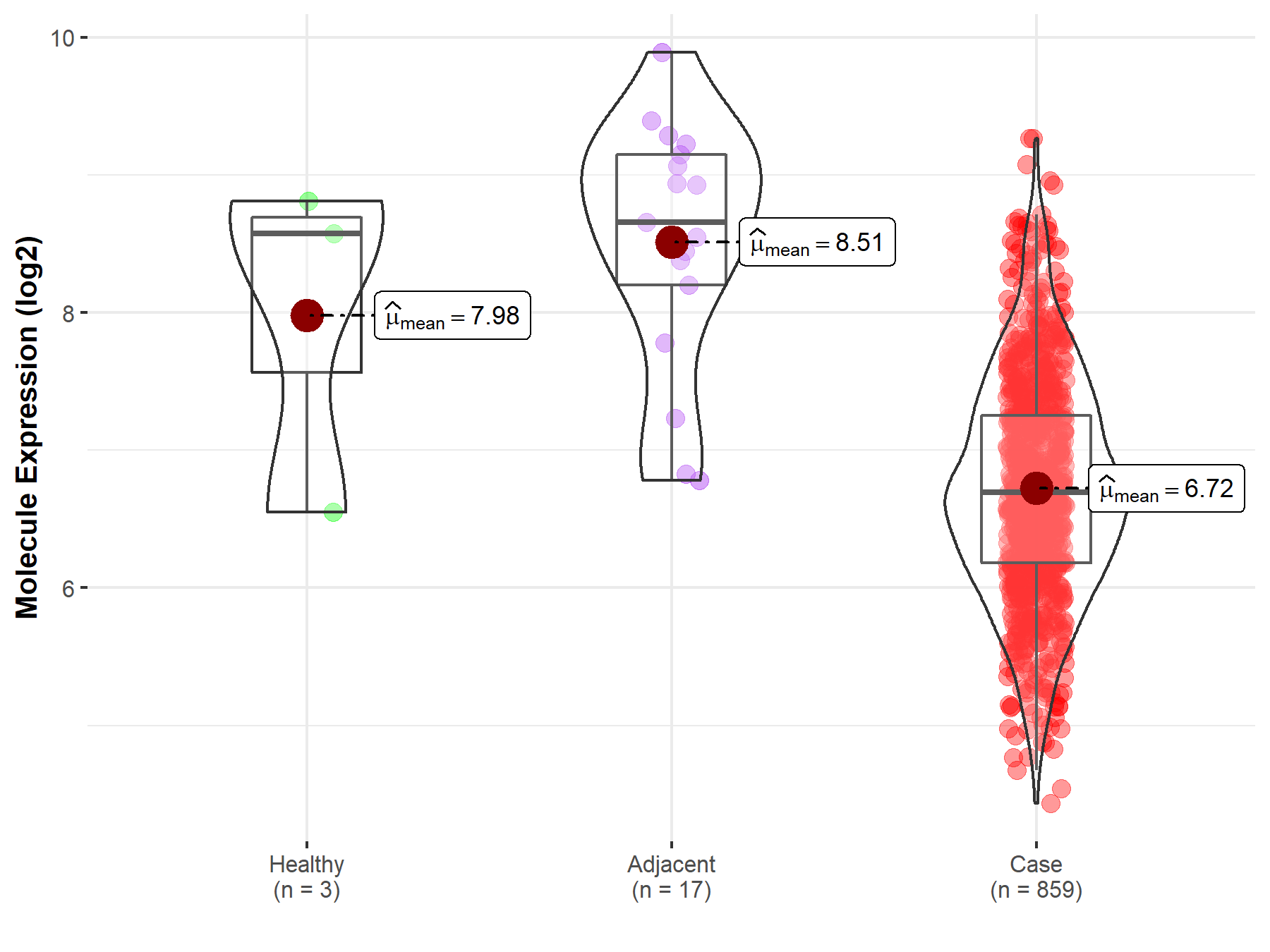
|
Click to View the Clearer Original Diagram |
| Differential expression of molecule in resistant diseases | ||
| The Studied Tissue | Pancreas | |
| The Specified Disease | Pancreatic cancer | |
| The Expression Level of Disease Section Compare with the Healthy Individual Tissue | p-value: 8.28E-03; Fold-change: 6.40E-01; Z-score: 7.46E-01 | |
| The Expression Level of Disease Section Compare with the Adjacent Tissue | p-value: 3.65E-08; Fold-change: 7.93E-01; Z-score: 9.67E-01 | |
|
Molecule expression in the normal tissue adjacent to the diseased tissue of patients
Molecule expression in the diseased tissue of patients
Molecule expression in the normal tissue of healthy individuals
|
||
| Disease-specific Molecule Abundances |

|
Click to View the Clearer Original Diagram |
| Differential expression of molecule in resistant diseases | ||
| The Studied Tissue | Breast tissue | |
| The Specified Disease | Breast cancer | |
| The Expression Level of Disease Section Compare with the Healthy Individual Tissue | p-value: 5.09E-71; Fold-change: 9.28E-01; Z-score: 1.48E+00 | |
| The Expression Level of Disease Section Compare with the Adjacent Tissue | p-value: 2.34E-07; Fold-change: 4.85E-01; Z-score: 7.87E-01 | |
|
Molecule expression in the normal tissue adjacent to the diseased tissue of patients
Molecule expression in the diseased tissue of patients
Molecule expression in the normal tissue of healthy individuals
|
||
| Disease-specific Molecule Abundances |
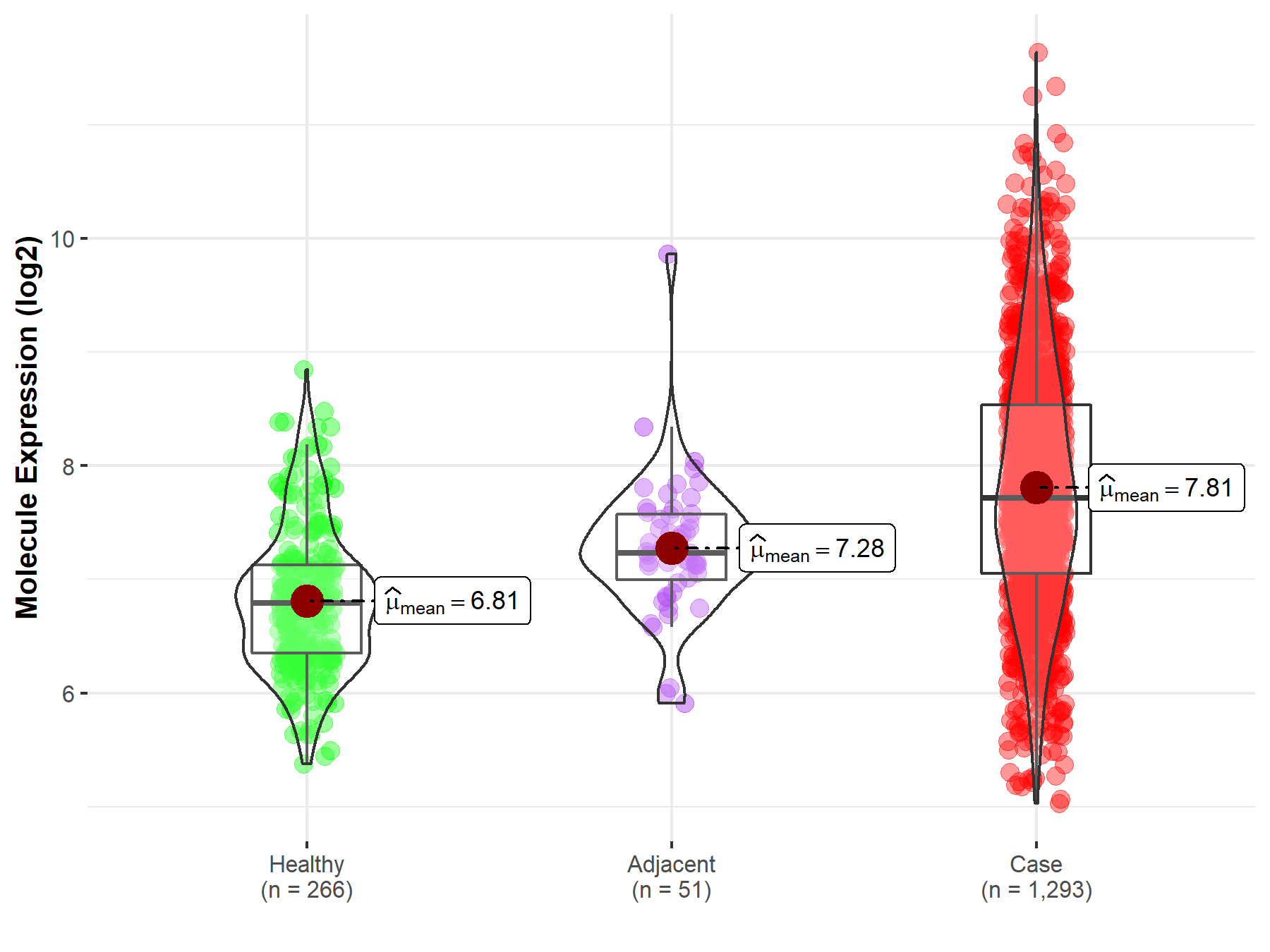
|
Click to View the Clearer Original Diagram |
| Differential expression of molecule in resistant diseases | ||
| The Studied Tissue | Ovary | |
| The Specified Disease | Ovarian cancer | |
| The Expression Level of Disease Section Compare with the Healthy Individual Tissue | p-value: 1.17E-02; Fold-change: 6.11E-01; Z-score: 7.54E-01 | |
| The Expression Level of Disease Section Compare with the Adjacent Tissue | p-value: 6.38E-03; Fold-change: 5.70E-01; Z-score: 8.66E-01 | |
|
Molecule expression in the normal tissue adjacent to the diseased tissue of patients
Molecule expression in the diseased tissue of patients
Molecule expression in the normal tissue of healthy individuals
|
||
| Disease-specific Molecule Abundances |
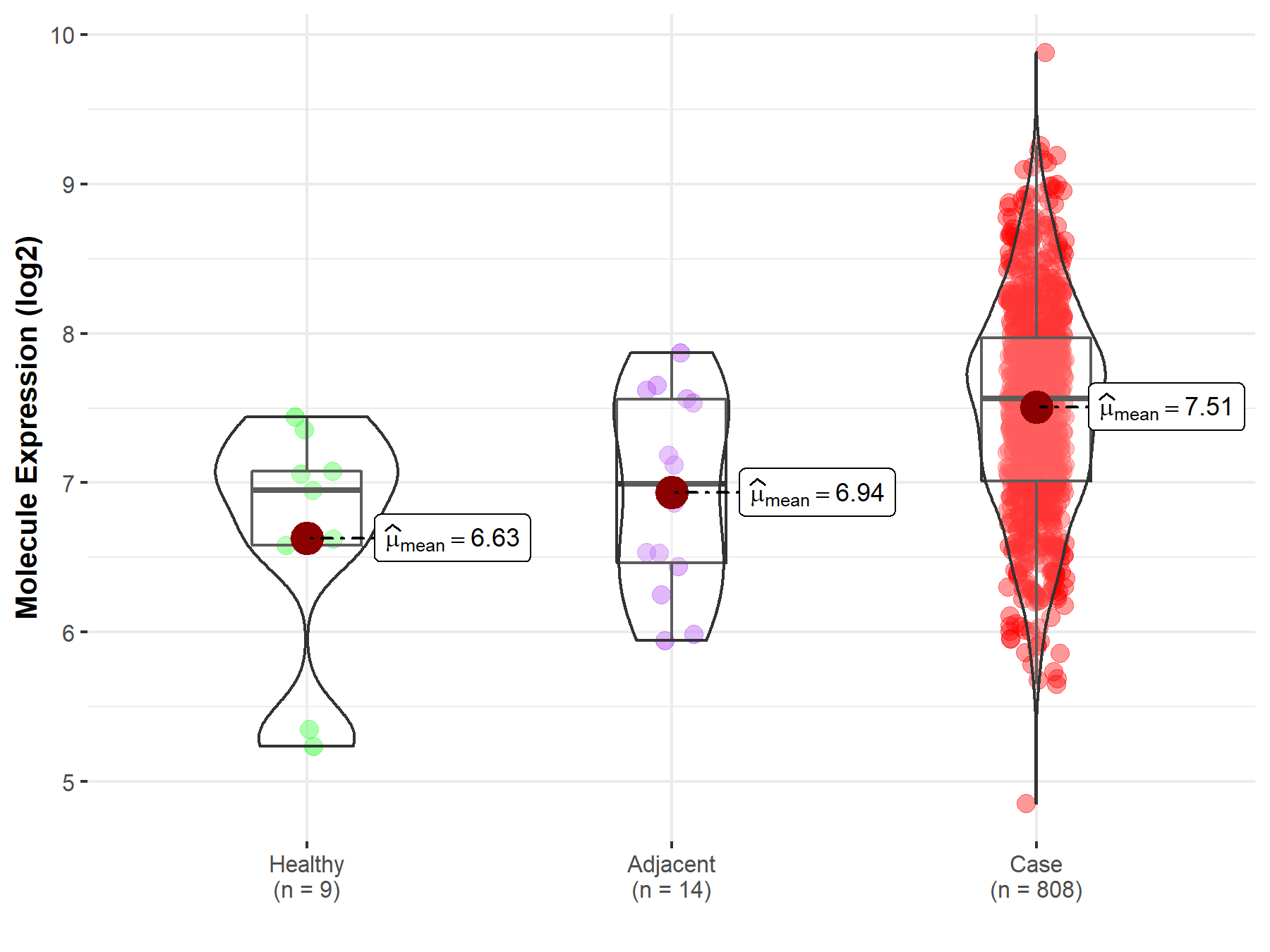
|
Click to View the Clearer Original Diagram |
ICD Disease Classification 15

| Differential expression of molecule in resistant diseases | ||
| The Studied Tissue | Peripheral blood | |
| The Specified Disease | Rheumatoid arthritis | |
| The Expression Level of Disease Section Compare with the Healthy Individual Tissue | p-value: 7.22E-01; Fold-change: -1.77E-02; Z-score: -5.99E-02 | |
|
Molecule expression in the diseased tissue of patients
Molecule expression in the normal tissue of healthy individuals
|
||
| Disease-specific Molecule Abundances |
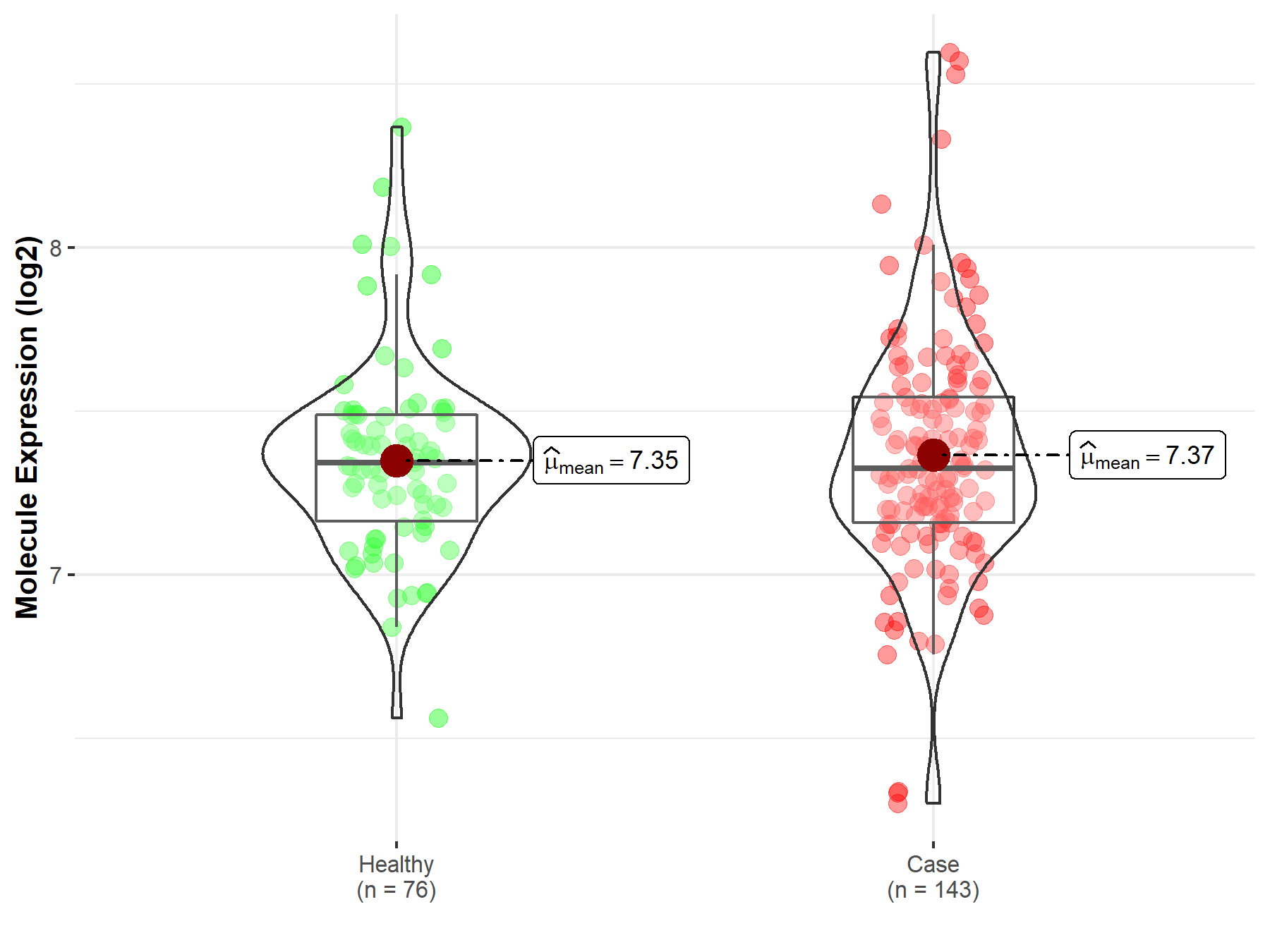
|
Click to View the Clearer Original Diagram |
| The Studied Tissue | Synovial tissue | |
| The Specified Disease | Rheumatoid arthritis | |
| The Expression Level of Disease Section Compare with the Healthy Individual Tissue | p-value: 4.38E-02; Fold-change: -3.21E-01; Z-score: -6.75E-01 | |
|
Molecule expression in the diseased tissue of patients
Molecule expression in the normal tissue of healthy individuals
|
||
| Disease-specific Molecule Abundances |

|
Click to View the Clearer Original Diagram |
Tissue-specific Molecule Abundances in Healthy Individuals

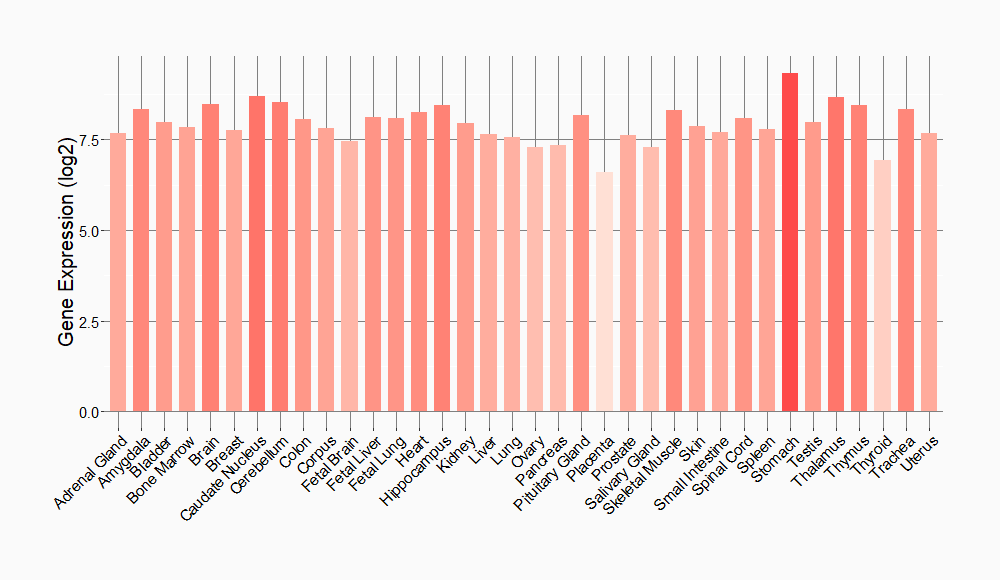
|
||
References
If you find any error in data or bug in web service, please kindly report it to Dr. Sun and Dr. Zhang.
